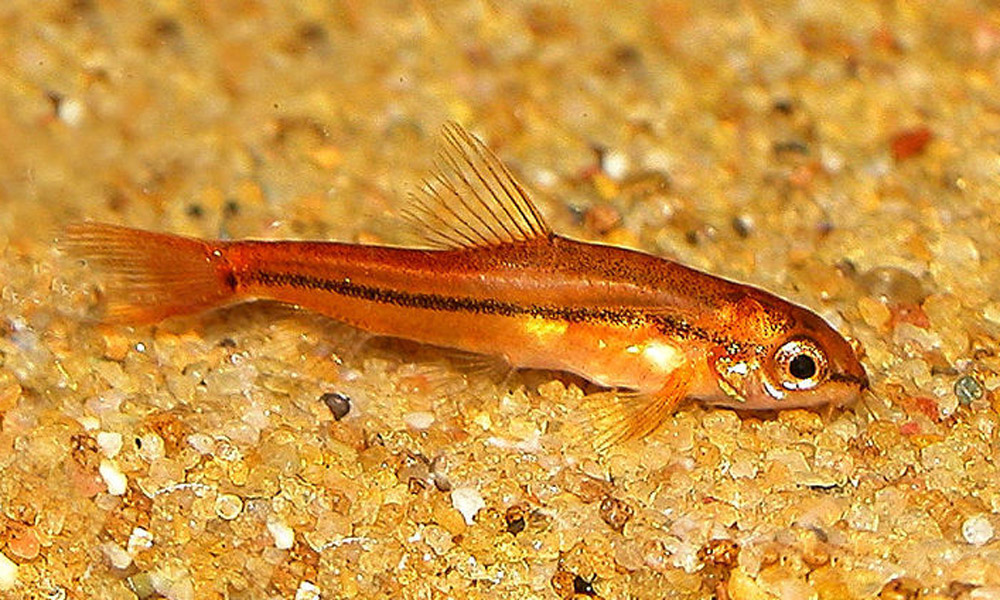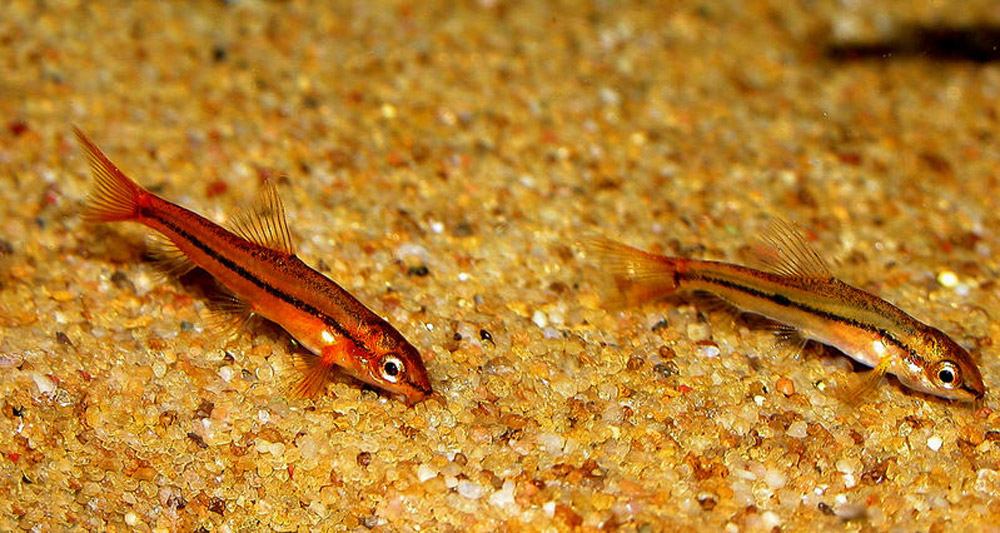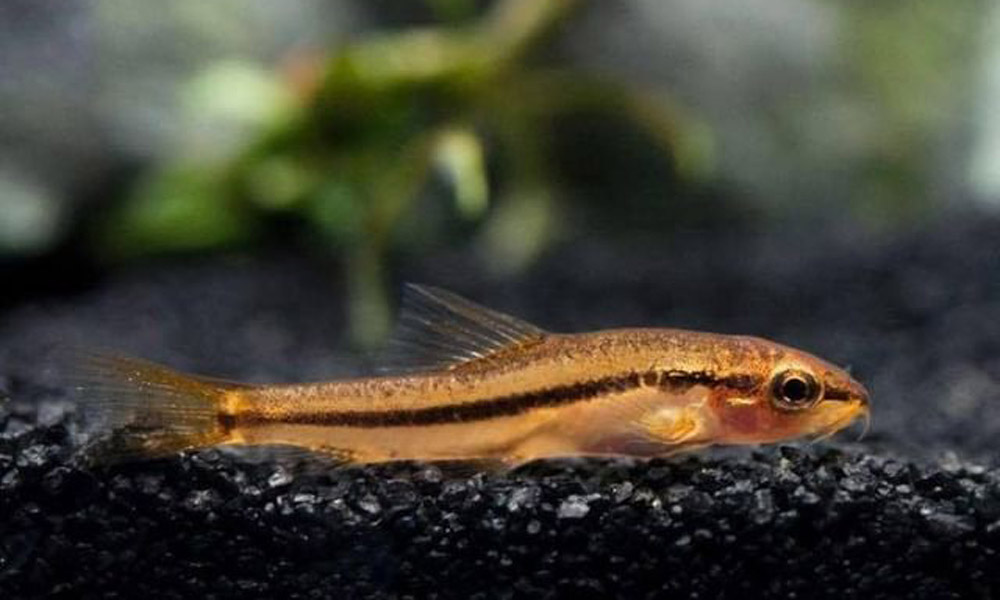The Rosy Loach is a wonderful freshwater fish that we recommend to heavily-planted aquariums. Many aquarists haven’t heard of them since they are not commonly found in the trade.
These rare fish are actually easy to care for and a joy to watch. They’re very active and outgoing personalities as well as attractive appearances.
But even though these beautiful are quite adaptable, it’s important to provide them with the right environment and diet if you want them to truly thrive.
So, in this article, we’re going to tell you everything you need to know about Rosy Loach’s care.
Species Summary
The Rosy Loach (Petruichthys sp. “Tuberoschistura arakanensis”) a fairly new species to the hobby, which has not yet been officially described by scientists. It was first imported into the UK in September/October 2006 and has been sold under the Latin name “Tuberoschistura arakanensis” given by the suppliers ever since.
However, this species doesn’t have many similarities with other Tuberoschistura species, so a new name is likely to be given in the future.
This species is native to Eastern Myanmar and northern Thailand, where it’s found in shallow waters (12 inches deep) with dense aquatic plants, including weed-choked ponds and shallow wetland areas.
Rosy loaches are unique among loaches because they spend most of their time foraging for food on the bottom or perched on plants and decorations. Additionally, these fish are known to be schooling fish and exhibit sophisticated social behavior. All of which, combined with their small size, it wouldn’t be hard to believe that these nano fish might ultimately be booming in the aquarium trade.
| Scientific Name: | – |
| Common Name: | Rosy Loach |
| Care Level: | Beginner |
| Origin: | Myanmar and Thailand |
| Lifespan: | 5 to 7 years |
| Max Size: | 1 inch (3 cm) |
| Temperature: | 72ºF to 79ºF (22-26°C) |
| PH: | 7.0-7.8 (7.3 is the sweet spot) |
| Water hardness: | 8 to 20 dKH |
| Diet: | Omnivorous |
| Minimum Tank Size: | 30 gallons |
| Temperament: | Peaceful |
Lifespan
On average, the Rosy Loach lifespan is somewhere between 5 and 7 years in captivity. This number is based on proper Rosy Loach care, which we will go over in more detail later on. Many seasoned aquarists have had their Rosy Loach live for much longer than that.
Appearance

There’s no denying that Rosy Loaches are gorgeous little creatures.
These fish have a long and slender body shape that is common among loaches. This particular species is sporting a red/orange hue along its body with a black line that goes from its snout all the way to its tail. The color intensity depends on each individual, but it’s usually deeper around the lateral stripe.
Females are quite similar to Pygmy Corydoras in terms of size and color. However, Rosy Loaches are longer and tend to have smaller, clear fins.
Male Vs. Female

Sexually mature female rosy loaches are typically larger and rounder-bellied than males, and they often take on a light grey base covered with fine irregular dark dots, plus the lateral line may be broken into many blotches.
As for color and pattern, males exhibit a red/orange body color but turn to almost bright orange when ready to spawn, particularly on the posterior part of the body.
Rosy Loach Size
Rosy loaches only grow to an average total length (TL) of about 1 inch (3 cm) and are quite underweight. On the large end of the spectrum, they may reach a size of 1.25 inches (3.2 cm), but that’s pretty rare in captivity.
Their size is pretty small, which is one of the reasons they’re so popular among aquarium enthusiasts.
Rosy Loach Care Guide
Contrary to what you might think, small fish are delicate and not as hardy as their larger counterparts. Rosy Loaches are no exception to that rule.
While Rosy Loaches are quite adaptable and can live in a wide range of water conditions, they’re still sensitive creatures that require proper care if you want them to thrive in captivity.
This section will cover everything you need to know about Rosy Loach’s care, from tank size and water parameters to diet and common health problems.
Tank Size
Our recommended tank size for Rosy Loaches is 30 gallons (36″ x 18″ x 12″). Some people say you can get away with as small as a 5-gallon tank, but we believe that’s too small for these fish.
Rosy Loaches are extremely active schooling fish, and these tiny critters should be kept in school of at least 8- 10 individuals. This is necessary for them to feel comfortable and secure in their environment. A small tank will not give them enough space to swim around and school properly.
Being a highly sociable species and they have their own social hierarchy, where each fish constantly tries to compete to be the Alpha by swimming faster than others. In a small tank, there simply isn’t enough space for Rosy Loaches to do that.
Unlike many African cichlids types, this behavior doesn’t involve real fighting but is only a means of establishing social dominance. As a result, this can help boost their coloration and activity.
Moreover, a small tank is more likely to experience water quality issues, which Rosy Loaches are also quite sensitive to when first imported.
Lastly, Rosy Loaches prefer to live in densely planted tanks with plenty of shady hiding places to mimic their natural habitat. A small tank will not give you enough space to create a proper setup for these fish, let alone a beautiful, original aquascape.
Water Parameters
Replicating Rosy Loach’s natural habitat is always going to be the best way to keep your Rosy Loaches healthy and happy.
Here are some important water parameters to aim for:
- Water temperature: 72ºF to 79ºF (22-26°C)
- pH levels: 7.0-7.8 (7.3 is the sweet spot)
- Water hardness: 8 to 20 dKH
The small size of the Rosy loach makes it relative hardiness when first introduced, so they are only being suitable for a ‘mature’ aquarium.
These fish come from high-oxygenated, low or moderate water flow ponds where the water is medium-hard with a neutral pH. A small air-powered sponge filter with a medium flow is ideal.
Because of the narrow range that Rosy Loaches can tolerate, we recommend investing in a reliable water test kit that will help you easily monitor these parameters on a regular basis.
- Contains one (1) API FRESHWATER MASTER TEST KIT 800-Test Freshwater Aquarium Water Master Test Kit,...
- Helps monitor water quality and prevent invisible water problems that can be harmful to fish and cause...
- Accurately monitors 5 most vital water parameters levels in freshwater aquariums: pH, high range pH,...
- Designed for use in freshwater aquariums only
- Use for weekly monitoring and when water or fish problems appear
It’s also very important to perform regular water changes of roughly 25% weekly to keep the tank clean and the water parameters in check.
Plants & Substrate

Their natural habitat is covered by live plants, mostly from the family Hydrocharitaceae, including Elodea spp. (Tape-Grass Family), Egeria spp., and Blyxa spp.. So, if you want to create a natural-looking Rosy Loach tank, you need to include plenty of live plants.
Plenty of hiding places created by driftwood roots or branches are appreciated. Some leaves and floating plants can also add to the natural feel of the tank.
Rosy Loaches are burrowers by nature and love to dig through the substrate in search of food. A sand substrate is ideal as it’s soft enough for Rosy Loaches to dig through without damaging the delicate sensory barbels.
Given that Rosy Loaches stay small, there is a chance they’ll get trapped under rocks or other decorations while digging, so be sure to create an open area in the middle of the tank for them to swim around.
Rosy Loach Food & Diet
Despite their small size, Rosy Loaches are omnivorous micropredators. In the wild, they mainly feed on small insects, crustaceans, worms, and vegetable matter.
In the aquarium, they will require a variety of appropriately sized meaty foods regularly. Frozen/live baby brine shrimp (BBS), daphnia, and mini-bloodworm will work great.
Rosy Loaches will accept most sinking pellets or crushed flake fry foods. You can also offer them some plant or algal material to supplement their diet.
A varied diet is always the best way to ensure your fish get all the nutrients they need.
Tank Mates
Unlike most loaches, Rosy Loaches also frequently flutter around mid-level or even at the top of the aquarium. As long as the school includes at least 8-10 fish, they don’t have a problem cohabitating with most small schooling fish of a similar disposition.
If the Rosy Loach is kept singly or in a group of less than 5, they may become stressed and aggressive.
You can also keep them with other bottom-dwelling fish in a large tank. Ensure these fish will not be too timid to come up for food, or they will starve.
Rosy Loach Breeding
Since these fish are rare in the hobby, Rosy Loach breeding is seldom successful in the home aquarium. Even if you’re lucky enough to stumble upon a Rosy Loach pair, getting them to successfully spawn is next to impossible.
According to a few reports, females will lay tiny, mildly adhesive eggs scattered over plants or other surfaces. The parents will not guard and take care of their offspring. Instead, they will eat them, so you may need to remove the parents or raise the fry in a separate tank.
The eggs should hatch in 24-36 hours, and the fry should be free swimming after another 24-36 hours, depending on the temperature.
Once the fry are free-swimming, they can be fed with infusoria. As they grow, you can start to feed freshly hatched brine shrimp or other small live foods.
FAQs:
Do Rosy Loaches Eat Snails?
Rosy Loaches may eat snails if they’re small enough. Don’t expect them to make much of a dent in a population of medium and larger snails due to the obvious reason – their small size.
Do Rosy Loaches Eat Algae?
Rosy Loaches do not specialize in eating algae but may nibble on it from time to time, especially if there’s not much else to eat. If you’re looking for an algae-eating fish, Rosy Loaches are not the best choice.
Do Rosy Loaches Eat Shrimp?
Rosy Loaches will eat baby brine shrimp (Artemia nauplii).
Where to Buy Rosy Loaches?
Rosy Loaches are not commonly available in local pet stores but can be found online from time to time. When buying Rosy Loaches, or any fish for that matter, be sure to purchase them from a reputable source to ensure they’re healthy and properly cared for.
Wrapping Up
Although Rosy Loaches are colorful and lively nano fish, they’re not suitable for small tanks. They’re best kept in a school of at least 10 fish in a tank no smaller than 30 gallons.
Rosy Loach care is not challenging and is a good choice for beginner fish keepers. They’re not fussy eaters and will accept most sinking pellets and flakes. Be sure to supplement their diet with live/frozen foods such as brine shrimp, daphnia, or bloodworms.
If there’s anything you think we missed or if you have any questions about something we covered, please leave us a comment below. As always, happy fishkeeping!






